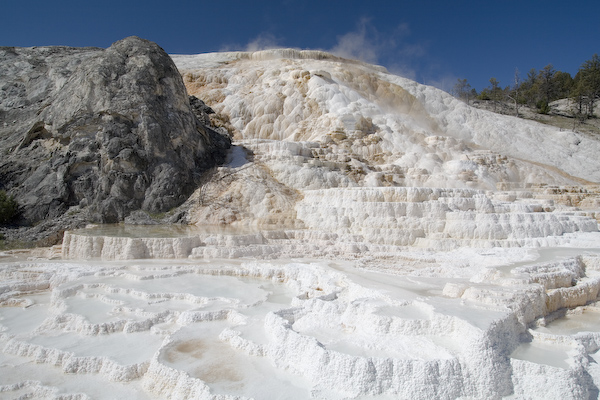The Polarizing Filter — A Keeper in the Digital Age
Yellowstone National Park has tremendous variety of scenery, and nearly every lens and gadget you’ll take with you can be used somewhere in the park. This particular attraction, Mammoth Hot Springs, is located near the northern edge of the park, and has some very interesting formations. These terraced pools were a wonder to see but, so incredibly bright with all the white mineral deposits reflecting the sunlight, they almost hurt your eyes to gaze upon them.
The scene in this image was awash in glare; light was reflecting intensely in all directions and the naked eye could not see all the detail and gradations in value that are present in this scene. Polarized sunglasses helped me to see what was really there through all of that glare. Using a polarizing filter on my lens allowed me to knock down a lot of the stray light and get this image.
In general, polarization is a great tool for intensifying color and cutting through reflections on the surface of water. With much of photography having gone digital, most of the filters we used to put on our lenses are of little use now, as their effects can be achieved (and with greater precision) during post-processing the image on the computer. The polarizing filter, however, achieves an effect that can only be modestly approximated on the computer (and then, only with a lot of work).
There are a few warnings for using polarizing filters. First, they come in two varieties: linear and circular; almost all modern cameras need the circular kind to be able to meter properly. Second, they can be thick and, on a wide-angle lens, can vignette the corners of the image; there are special “thin” versions available that reduce this problem. Third, they can be over used. The degree of polarization is variable, adjusted by rotating the outer ring of the filter. What looks good to our eyes when looking through the lens will often turn out too dark in our images — this is especially true of the deep blue skies which can easily become indigo. I recommend rotating the filter to find the point of maximum polarization and then backing off from that somewhat (perhaps 10° - 20°).
It’s worth mentioning that the polarizer can also be used as a neutral density filter, which is useful for allowing longer shutter speeds when taking pictures of moving water, as demonstrated on another blog entry.

Tip of the Week
2007.07.09

